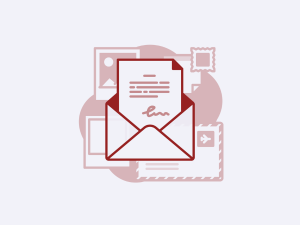This post is also available in: Português
There’s a lot that goes into effective email writing. Whenever you craft a formal email, you need to make sure your emails follow the right structure, include the correct elements, and use the proper tone. Knowing when to send emails and when to use other communication methods is also essential.
Follow this guide to learn how to write professional emails. We cover everything you need to know to set a positive tone and maintain a professional relationship with each email you send.
What is an email thread?
An email thread refers to a series of email messages in one email conversation made up of messages and replies.
Messages are grouped together in chronological order so that recipients can view the history of the conversation instead of having to sort through individual emails. This is one of the most common forms of professional communication.
Example of an email thread with 4 messages:
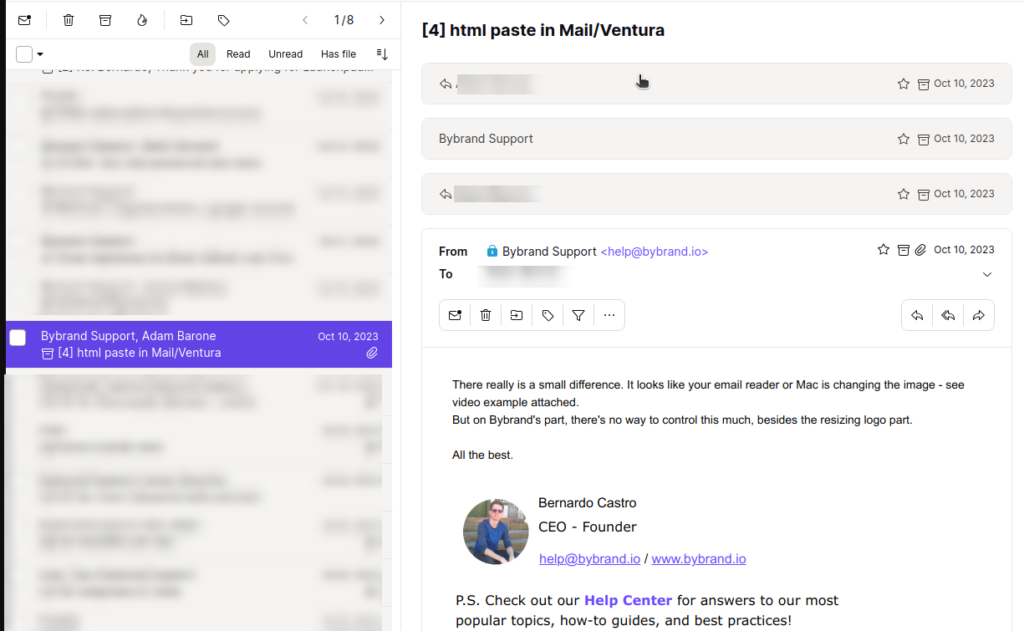
Here are some of the key characteristics of email communication in a thread:
- A single subject: All emails in the thread share the same subject line, making it easy to identify and follow the conversation’s topic.
- Inclusion of previous messages: Each email in the thread usually includes the text of the previous messages in the conversation. This allows participants to easily reference earlier messages for context.
- Chronological messaging: Messages in the thread are displayed in the order they were sent, with the most recent response appearing at the top.
- Replying and forwarding: Participants can reply to specific messages within the thread or forward the entire thread to others, allowing for seamless communication and collaboration.
Understanding email structure
Writing professional emails should always be done with the same basic structure. Below is an example of a well-crafted email message.
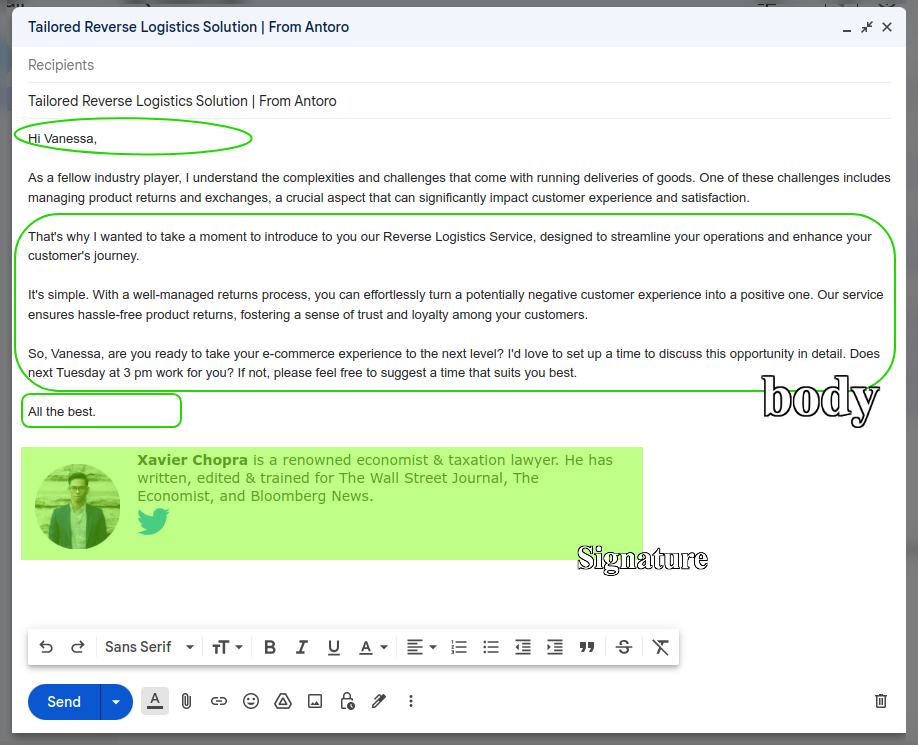
Here are the key elements to include in any email writing process:
Email subject line
The subject line is the first thing recipients see, so make it clear and concise. It should accurately summarize the email’s main purpose or topic.
Avoid using vague or generic subject lines, even worse with the text in Caps Lock active. Be specific to grab the recipient’s attention.
It is also not a good practice to change the subject of the email within the same thread.
Greeting
Begin your email with a polite salutation, such as “Dear Mr. Smith” or “Hello [Recipient’s Name].” If you don’t know the recipient’s name, use a generic greeting like “Hello” or “Good morning.”
Opening paragraph
When it comes to effective email writing, starting strong is essential.
Start with a courteous and professional tone, and make sure you grab the recipient’s attention straight away.
Provide context or briefly mention the reason for your email. If it’s a follow-up, reference the previous correspondence.
Body of the email
In any email writing format, this is where you include the bulk of your email’s information. You want to make sure it’s presented in a clear and easy-to-understand way.
Organize your content into paragraphs for readability. Be concise and get to the point. Avoid lengthy, unnecessary information. Use bullet points or numbered lists for clarity when presenting multiple items.
Closing and signature
Use a courteous closing to end your email, such as “Sincerely” or “Best regards,” followed by your name.
Include your contact information (phone number and, if appropriate, your professional title) below your name. Of course, having a professional email signature as a standard part of all emails is the best approach to take.
10 email writing best practices (How to write a business email)
There may be much different email writing format samples out there, but they all follow the same best practices.
Whenever you send a message from your work email address, you need to make sure it ticks all the right boxes. To help you with effective email writing, here are some key elements and proper etiquette for any formal email.
1. Know your audience
Understand who you are writing to and tailor your tone and content accordingly. Consider their position, familiarity with the topic, and preferences.
For example, writing “Dear hiring manager” is more professional than writing “Hi there”.
2. Use a professional email address
Use a professional email address that includes your name or company name, rather than a personal or unprofessional address. The same rule applies to email signatures, see the difference between a professional and a personal signature.
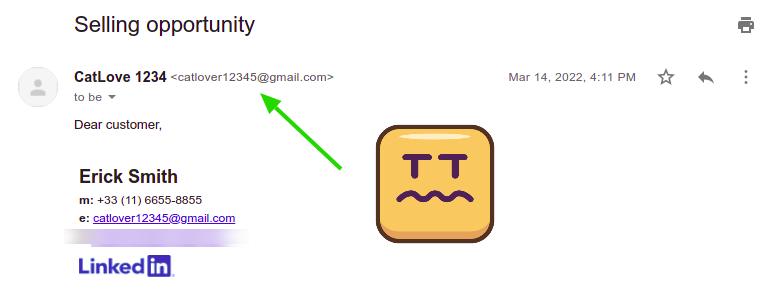
3. Use a professional email signature
A well-crafted email signature adds a lot of extra value to your email communications. It ensures recipients have all of the necessary information about you, helping to make communications more effective and personal.

It also goes a long way in promoting your company, making your job title clear, and helping you spread brand awareness.
Read also: Email signature etiquette: Dos and Don’ts.
4. Start with a strong subject line
Craft a subject line that is both specific and attention-grabbing to ensure your email gets noticed. Of course, you’ll need to make sure your email actually relates to your subject line.
5. Get to the point quickly
Begin your email with the most important information. Busy professionals appreciate a concise and direct approach.
6. Be clear and concise
Keep your sentences and paragraphs short and focused on a single idea or topic. Avoid unnecessary jargon or complexity.
7. Proofread thoroughly
This may sound obvious, but far too many professional emails are sent out with simple spelling mistakes.
Check for spelling, grammar, and punctuation errors before sending. Errors can seriously undermine your professionalism. Using tools like LanguageTool or Grammarly is great for this purpose.
8. Avoid emojis and abbreviations
Save emojis, abbreviations, and informal language for more casual communications. Business emails should maintain a formal tone.
9. Avoid large attachments
If you need to send large files, consider using file-sharing services like Google Drive or Dropbox instead of clogging the recipient’s inbox.
10. Be respectful of time
Keep your emails concise and respect the recipient’s time. Avoid sending lengthy emails unless it’s truly necessary.
As far as time is concerned, the periods between 9am and 11am and between 1pm and 2pm are the most suitable, as people tend to check their emails before work and during their lunch break.
Using AI to write emails
For professionals who work with email daily. It is a good idea to use an artificial intelligence assistant to help write and improve the message, thus reducing the effort and time spent writing each email.
In addition, AI can also help solve common problems faced when writing emails, such as grammatical errors, inappropriate tone or incorrect use of words. With its ability to learn from previous data and understand linguistic nuances, incorporating AI into email communication can significantly improve productivity.
There are several artificial intelligence tools that can be used to assist in working with emails, check out the list of 5 tools:
- Jasper AI: recommended for creating subject lines and greetings
- WriteSonic: similar to Jasper AI
- LanguageTool: works with multiple languages
- QuillBot: useful for improving the grammar, spelling, style and tone of emails
- SmartWriter: a program that helps make emails more personalized and customized
LanguageTool’s example working in the body of the email.
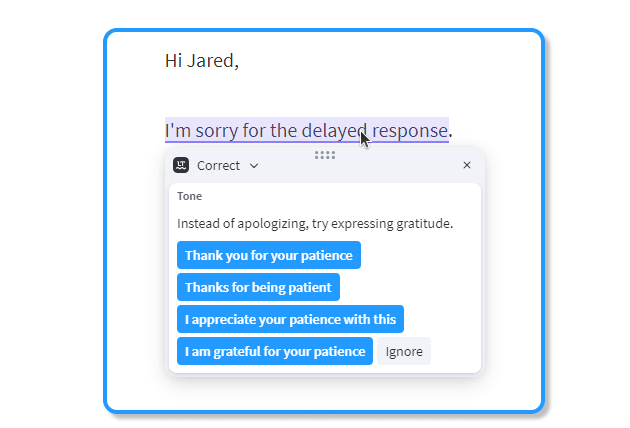
When to use email conversation
Email is one of the most common communication methods. Yet, an important part of email etiquette is knowing when to write an email and when to choose other communication channels.
Here are some of the main scenarios where email is best:
Customer support
Any customer service representative should focus on email. Use email conversations for non-urgent customer inquiries. Respond promptly, address issues clearly, and maintain a professional tone.
Sales
Sales emails help you nurture leads and communicate with clients. Personalize these emails, provide enough information in them, and always include clear calls to action.
Marketing
Email remains the number one marketing channel for any business. Your marketing team can use email for sending newsletters, and promotions, and keeping your customers engaged.
Internal email
Companies can also use email conversations for team collaboration and any internal information sharing.
When not to use email
Email may be an effective communication channel, but there are also plenty of occasions where it doesn’t make sense. This includes:
- Long conversations: Long back-and-forth email threads are often best managed as a meeting or phone call.
- Quick messages: In situations where instant messaging platforms like Slack or Teams would be more efficient for real-time communication.
- Emergency: when there is a need for an immediate response.
- Dealing with conflicts: because tone and language can be misinterpreted.
Should you show your email signature on Reply or not?
Whether to show your email signature on a reply depends on the context of the email thread. Here are some guidelines to help you decide when to do this.
When to show email signature on reply:
- It’s the first time you’re communicating with the recipient in the thread.
- The recipient may need your contact information or title for reference.
- The email thread involves multiple recipients who may benefit from your contact details.
- The email thread has been ongoing, but you want to reinforce your professional identity.
When to remove your email signature on Reply:
- You’ve already shared your contact information earlier in the initial email.
- The thread is short, and including the signature in a follow-up email may add unnecessary clutter.
- It’s a back-and-forth conversation with colleagues who are already familiar with your details.
- You want to keep the reply as concise and focused as possible.
Watch the video, removing signature in major email clients.
Final thoughts
A poorly written email can be incredibly unprofessional. Follow these guidelines for all future conversations you have with email. It will help you maintain professionalism and make it easier to achieve your email communication goals.

Create your first email signature with Bybrand
Bybrand offers the ability to generate, administer, and distribute essential email signatures for your employees.
